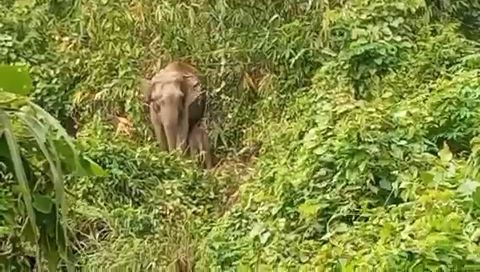In this screengrab from a video shared by villagers, an elephant and a calf are seen near the vicinity of Ruchan village. (Morung Photo/screengrab)

Morung Express News
Wokha | May 28
Ruchan village under Bhandari Sub-Division in Wokha district is reportedly facing a human-wildlife conflict after large herds of wild elephants—estimated to number between 50 and 70, entered the area on Sunday, causing extensive damage to farmland and residential structures.
According to village sources, the elephants have trampled large swathes of agricultural land and destroyed essential structures, including homes and plantation crops.
The villagers, who primarily depend on farming for their livelihood, are now facing disruption to daily life and heightened fear due to the sudden incursion and continued presence of the animals on the village outskirts, the sources added.
It was informed that the herds remained in the vicinity of Ruchan, with villagers expressing apprehension over further damage to crops and potential threats to human safety.
Accordingly, the villagers have appealed to the district administration and wildlife authorities for immediate intervention to alleviate the situation, including the deployment of forest personnel, installation of elephant deterrent systems, and implementation of long-term mitigation strategies to manage human-elephant conflict.
There was no official statement on the issue at the time of filing this report.
It must be note here that sightings of wild elephants near human settlements in Nagaland have been on the rise in recent years.During a meeting to address the ‘escalating issue of human-elephant conflict’ at the Liphayan Beat, Wokha, in October 2024, Wildlife Warden of the Wildlife Division, Dimapur, Tokaho Kinimi, informed that major conflict zones in Nagaland include Peren, Dimapur, Niuland, Mokokchung, Wokha, Zunheboto, Longleng, and parts of Mon district.
He reported that the 2017 census recorded 446 elephants in Nagaland and that a new census is scheduled to take place soon.
The officer attributed the reduction in elephant habitats-from over 150 square kilometres to less than 50 square kilometres due to farming and plantations- as a primary reason for the increasing conflicts.
He also informed that a state action plan to tackle the issue has been submitted but remains pending approval.
The current status of the action plan is unknown.






